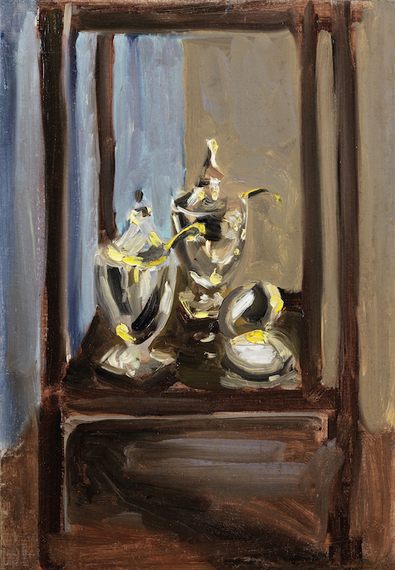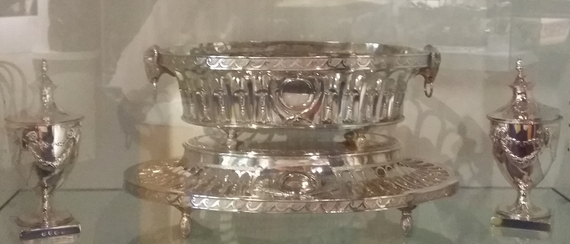
I recently held one of Winston Churchill's paintings in my hands. It was a first for me. And a story worth telling.
Winston Churchill completed exactly 537 paintings. They are relatively easy to count; nearly all of them still reside at Chartwell, his home, hanging on the walls of the house itself or in his painting studio, stacked carefully in corners or filling purpose-constructed nooks from floor to ceiling.
It is rare for one of these paintings to leave Chartwell. Those that have, generally departed as gifts presented by Churchill himself, who sometimes gave paintings away but never sold a one. His family inherited them all, in various groupings, but generally have left the paintings where they are. Lady Mary Soames, Churchill's youngest daughter, who passed in May 2014, altered this practice slightly. As was her right, she kept her favorite pictures by her father in her home. At the end, her family gifted to the British government 37 paintings, in lieu of inheritance taxes. Two were allowed to remain as loans on display, at the Churchill War Rooms, and the House of Commons, respectively. The remaining 35 paintings stayed at Chartwell. A further 15 went to auction, realizing record-breaking prices -- the top seller, "Gold Fish Pool at Chartwell," going for £1.8 million (roughly $2.7 million).
"Silver Life" is a striking still-life, painted at Chartwell by Churchill in the 1930s; his so-called "Wilderness Years." Out of power, out of office and, increasingly out of money, Churchill clung to Chartwell, writing articles and books there in a frenzy to pay the bills, and painting to preserve his sanity.
"Silver Life" came to pass through my hands in a manner I cannot divulge -- perfectly correct but also perfectly private. In fact, I only raise the matter because "Silver Life" will be auctioned by Bonhams in London this Wednesday (November 18, 10:00 a.m New York time) in a "Modern British and Irish Art" sale, which means that any one of you can potentially hold it in your hands, as I did - and for a much longer time.
It is a wonder to behold. The three objects that constitute "Silver Life" are, I learned, two silver lidded vases with ladles, the work of Mapp & Webb, circa 1915, and a lidded ashtray of indeterminate date. This past summer, the vases were on display at Chartwell. I went to visit them with my daughters in August and found them to be dazzling.
Not quite so dazzling, however, as Winston Churchill's conjuring of them in oils. To look at this painting up close (to even run one's fingers very carefully across its surface) is to marvel at Churchill's unexpectedly tactile impasto technique, the lustrous physicality of his brush strokes, particularly the glittering yellows of light reflecting off the silver pieces.
Mary Soames wrote about her father's affinity for still-life. "Forced indoors by the weather, he would look around him for subjects. Members of his family or friends would advise, or hurry to help him compose a 'paintatious group.' It might be a 'bottlescape' like the one that hangs in the dining room at Chartwell...or a study in silver... He had taken his first lesson in still-life painting when he had copied the Sargent in Philip Sasoon's collection, way back in the twenties."
David Coombs, our foremost authority on Churchill the Painter, the compiler of Churchill's catalogue raisonné, has contributed an exquisite essay about "Silver Life" to Bonhams' auction catalogue. "By any objective standards, this painting is a splendid example of 'Modern British Art,' he writes. "That it is by Winston Churchill may come as a surprise to many -- but not to those who, in recent times especially, have come to appreciate the real quality of his best work."
Mr. Coombs notes the ineffable influence here of the artist William Nicholson, who lived at Chartwell as a more or less permanent houseguest during the period in which "Silver Life" was painted. Nicholson was "a peerless master of still-life painting," Coombs notes. "Which being said, 'Silver Life' is, in its characteristic dash and verve... representative in every way of Churchill's own and very best work."
All true. But something else struck me about "Silver Life" up close. There is a storminess to the gold and brown background strokes of what Coombs terms "a diaphonous curtain," and an unsettledness to the wall of sky blue, shot through with melancholic tones of violet. There is also much black in the silver. The gold daubs struggle mightily to burst through, glimmers of sunshine in a rich, moody canvas. Could "Silver Life" be a painting of Churchill's tortured psyche in the mid-1930s and his determination to triumph over his troubles and glitter once more?
You decide.
~

